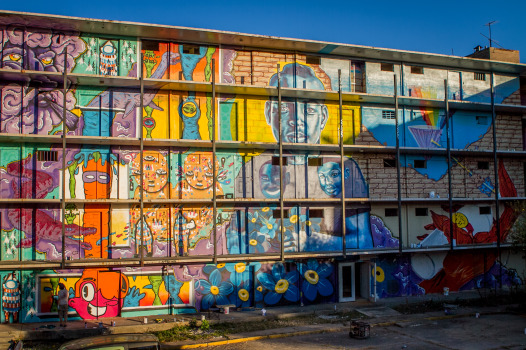Editor’s Note: Prospect 3 Plus offers more than 60 local art installations and events taking place alongside the international Bienennial Prospect 3. NolaVie and its cultural partner, WWNO public radio, are taking a look at some of them in a series to run during the exhibition, which continues through Jan. 25.

As part of Prospect 3 Plus, artist Brandan Odums has turned a blighted building into a street art masterpiece.
Brandan Odums grew up on the West Bank, Algiers to be specific. He attended Edna Karr School and NOCCA, where he trained as a visual artist, and then on to the University of New Orleans where he learned how to make films. Neither of those undertakings, at which he excelled, completely fulfilled his artistic aspirations. It was as if something was missing.
“When I was a kid, I could draw well and folk said ‘oh you’re going to be an artist,’” he says. “I didn’t really know what that meant. But I pursued art into high school. I couldn’t figure out why I was doing it. I figured out how to do it; I just couldn’t figure out the why.”
So Brandan stopped making art until he discovered street art, which to him, he says, is the most honest form of expression. Those who do it, he explains, are not looking to sell their creations or have them hang in art galleries. He describes it as a kind of democratization of art, the people’s art. And while that whole philosophy struck a chord with Brandan, it didn’t mesh with what he learned in school.
“In fine art you justify yourself on how well your art sells; how much your art is shown,” he explains. “So if you don’t have any of those things to your name you feel unaccomplished as an artist. At least that’s the way I interpreted the message I was receiving as a student.”
Now Prospect 3+ has given Brandan and a group of street artists that he has pulled together the opportunity to make a big statement — to demonstrate and justify what Brandon describes as the unapologetic creativity of an art form often viewed negatively.
“Street art is not commodified,” he says. “It’s done solely from the artists at the expense, sometimes great expense, of either getting arrested or getting in trouble. So there’s a guerilla side of it when you do it in that illegal gray area.”
There’s nothing illegal in Brandan’s P3+ project. He has the permission of the owners and is encouraging all the artists involved to do what he always does with a public space: honor a certain narrative or historical element surrounding that location.
“You see in a lot of urban areas a movement to reclaim public spaces,” he explains. “So you see a lot of storefronts and sides of buildings being used to create murals. That really allows people to appreciate art from a different perspective.
“I think there’s a sort of redemptive quality of turning nothing into something,” he adds. “It’s a form of artistic alchemy, the transformative power of art. I think what we’re doing on the West Bank on our P3+ site is one of the best examples of that.”
It’s this function of street art that has made a believer out of Brandan.
“This whole movement is more than art for art’s sake,” he says. “It’s the idea that art has power and artists yield that power.”
So spray cans at the ready — having included the nearby community in the planning and with the approval and support of the owners — Brandon and his graffiti group have transformed one whole section of De Gaulle Manor, a 360-unit blighted apartment complex on Sandra Drive off Gen deGaulle Drive on the West Bank, into the largest street art project in the South.
This past Saturday, hundreds of people shvisited the site, one that has been sitting in decay for the past eight years for the grand opening. The response was amazing. There was (for those of us of a certain age) a sort of ‘60s vibe — peaceful, respectful, gentle. It’s a spirit that will likely continue on a select number of Saturdays through the run of Prospect 3 which will close out in January 2015.
For more information about this unique project, its location and viewing times, visit www.exhibitBE.com.
This series on Prospect 3 Plus artworks is made possible by a generous grant from the lawyers of the Lugenbuhl firm, with offices in New Orleans, Baton Rouge and Houston, in support of art in the Gulf South.
 NOLAbeings Multimedia artist Claire Bangser created NOLAbeings as a portrait-based story project that marries...
NOLAbeings Multimedia artist Claire Bangser created NOLAbeings as a portrait-based story project that marries...  Voodoo in New Orleans: Reviving history: New Orleans fortune telling This article takes a deep dive into the history of Voodoo in New Orleans, its hybridization with Catholicism, and its present-day place in the city's culture. The author visits fortune-tellers in the French Quarter, using their guidance as a tool for introspection rather than a deterministic predictor of the future. Through her experiences in New Orleans, the author feels a mystical connection to both the past and the future.
Voodoo in New Orleans: Reviving history: New Orleans fortune telling This article takes a deep dive into the history of Voodoo in New Orleans, its hybridization with Catholicism, and its present-day place in the city's culture. The author visits fortune-tellers in the French Quarter, using their guidance as a tool for introspection rather than a deterministic predictor of the future. Through her experiences in New Orleans, the author feels a mystical connection to both the past and the future. 